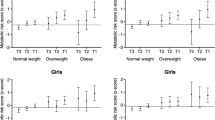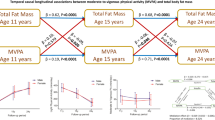Abstract
BACKGROUND AND OBJECTIVE:
Waist circumference (W) has been shown to be a good predictor of cardiovascular risk. The aim of this study was to investigate whether physical activity (PA) is related to W in adolescents as previously shown in adults.
DESIGN AND SUBJECTS:
Cross-sectional population-based survey of 2714 12-y-old adolescents from the eastern part of France.
MEASUREMENTS:
Body mass index (BMI) and W were measured. Structured PA, active commuting to and from school and sedentary activities (SED), for example television viewing, computer/video games and reading and different potential confounders (dietary habits, parental overweight, family annual income tax and educational level) were assessed by a questionnaire.
RESULTS:
The adolescents had a mean BMI of 19.0±3.4 kg/m2, and 20.2% of them were overweight, with no gender difference. Boys had a greater W than girls (67.6±9.1 vs 65.7±8.9 cm, P<0.0001). In all, 42% of the girls and 25% of the boys did not practice any structured PA outside school and less than 40% of the adolescents commuted actively to school more than 20 min/day. About one-third of the adolescents devoted more than 2 h/day to SED. In univariate analyses, BMI was negatively associated with structured PA but significantly only for girls (P<0.01) and positively associated with SED for both genders (P<0.0001 for girls, P<0.01 for boys). W was negatively associated with structured PA and positively associated with SED both in girls (P<0.0001 and P=0.03, respectively) and boys (P<0.01 and P=0.08, respectively). Multiple general linear models show that SED is associated with BMI, independently of structured PA, in both genders. On the other hand, structured PA was inversely associated with W, independently of SED. The inverse relation between structured PA and W persisted after additional adjustment on BMI, with a greater effect of PA for the adolescents with higher BMI.
CONCLUSIONS:
In 12-y-old adolescents, structured PA is inversely associated with W, an indicator of total adiposity but also more specifically of abdominal fat. This suggests that PA may have a beneficial effect on youth metabolic and cardiovascular risks, in particular in the presence of overweight.
This is a preview of subscription content, access via your institution
Access options
Subscribe to this journal
Receive 12 print issues and online access
$259.00 per year
only $21.58 per issue
Buy this article
- Purchase on Springer Link
- Instant access to full article PDF
Prices may be subject to local taxes which are calculated during checkout

Similar content being viewed by others
References
Livingstone B . Epidemiology of childhood obesity in Europe. Eur J Pediatr 2000; 159 (Suppl 1): S14–S34.
Robinson TN . Television viewing and childhood obesity. Pediatr Clin North Am 2001; 48: 1017–1025.
Kaur H, Choi WS, Mayo MS, Harris KJ . Duration of television watching is associated with increased body mass index. J Pediatr 2003; 143: 506–511.
Gortmaker SL, Must A, Sobol AM, Peterson K, Colditz GA, Dietz WH . Television viewing as a cause of increasing obesity among children in the United States, 1986–1990. Arch Pediatr Adolesc Med 1996; 150: 356–362.
Andersen RE, Crespo CJ, Bartlett SJ, Cheskin LJ, Pratt M . Relationship of physical activity and television watching with body weight and level of fatness among children: results from the Third National Health and Nutrition Examination Survey. JAMA 1998; 279: 938–942.
Eisenmann JC, Bartee RT, Wang MQ . Physical activity, TV viewing and weight in U.S. Youth: 1999 Youth Risk Behavior Survey. Obes Res 2002; 10: 379–385.
Goran MI, Reynolds KD, Lindquist CH . Role of physical activity in the prevention of obesity in children. Int J Obes Relat Metab Disord 1999; 23: S18–S33.
Molnar D, Livingstone B . Physical activity in relation to overweight and obesity in children and adolescents. Eur J Pediatr 2000; 159: S45–S55.
Taylor RW, Jones IE, Williams SM, Goulding A . Evaluation of waist circumference, waist-to-hip ratio, and the conicity index as screening tools for high trunk fat mass, as measured by dual-energy X-ray absorptiometry, in children aged 3–19 y. Am J Clin Nutr 2000; 72: 490–495.
Savva SC, Tornaritis M, Sedvva ME, Kourides Y, Panagi A, Silikiotou N, Georgiou C, Kafatos A . Waist circumference and waist-to-height ratio are better predictors of cardiovascular disease risk factors in chidren than body mass index. Int J Obes Relat Metab Disord 2000; 24: 1453–1458.
Han TS, van Leer EM, Seidell JC, Lean ME . Waist circumference as screening tool for cardiovascular risk factors: evaluation of receiver operating characteristics (ROC). Obes Res 1996; 4: 533–547.
Klein-Platat C, Wagner A, Haan MC, Arveiler D, Schlienger JL, Simon C . Prevalence and sociodemographic determinants of overweight in young French adolescents. Diabetes Metab Res Rev 2003; 19: 153–158.
Cole TJ, Bellizzi MC, Flegal KM, Dietz WH . Establishing a standard definition for child overweight and obesity worldwide: international survey. Br Med J 2000; 320: 1240–1243.
Rolland-Cachera MF, Cole TJ, Sempé M, Tichet J, Rossignol C, Charraud A . Body mass index variations: centiles from birth to 87 years. Eur J Clin Nutr 1991; 45: 13–21.
Lohman TG . Applicability of body composition techniques and constants for children and youth. Exerc Sport Sci Rev 1986; 14: 325–357.
Pereira MA, Fitzgerald SJ, Gregg EW, Joswiak ML, Ryan WJ, Suminski RR, Utter AC, Zmuda JM . A collection of physical activity questionnaires for health-related research: the modifiable activity questionnaire for adolescents. Med Sci Sports Exerc 1997; 29: S79–S82.
Aaron DJ, Kriska AM, Dearwater SR, Cauley JA, Metz KF, Laporte RE . Reproducibility and validity of an epidemiologic questionnaire to assess past year physical activity in adolescents. Am J Epidemiol 1995; 142: 191–201.
Pate RR, Trost SG, Levin S, Dowda M . Sports participation and health-related behaviors among US youth. Arch Pediatr Adolesc Med 2000; 154: 904–911.
Krassas GE, Tzotzas T, Tsametis C, Konstantinidis T . Determinants of body mass index in Greek children and adolescents. J Pediatr Endocrinol Metab 2001; 14: 1327–1333.
Maffeis C, Talamini G, Tato L . Influence of diet, physical activity and parents' obesity on children's adiposity: a four-year longitudinal study. Int J Obes Relat Metab Disord 1999; 22: 758–764.
McMurray RG, Harrell JS, Deng S, Bradley CB, Cox LM, Bangdiwala SI . The influence of physical activity, socioeconomic status, and ethnicity on the weight status of adolescents. Obes Res 2000; 8: 130–139.
Robinson TN . Reducing children's television viewing to prevent obesity: a randomized controlled trial. JAMA 1999; 282: 1561–1567.
Hunter GR, Weinsier RL, Bamman MM, Larson DE . A role for high intensity exercise on energy balance and weight control. Int J Obes Relat Metab Disord 1998; 22: 489–493.
DiPietro L . Physical activity, body weight, and adiposity: an epidemiologic perspective. Exerc Sport Sci Rev 1995; 23: 275–303.
Gutin B, Owens S . Role of exercise intervention in improving body fat distribution and risk profile in children. Am J Human Biol 1999; 11: 237–247.
Boreham CA, Twisk J, Savage MJ, Cran GW, Strain JJ . Physical activity, sports participation, and risk factors in adolescents. Med Sci Sports Exerc 1997; 29: 788–793.
Acknowledgements
This study was made possible by the financial support of the Régime Local de la Caisse Régionale d'Assurance Maladie d'Alsace et de Moselle. We thank the medical staff of the schools for their participation in the data collection and F Ghazlane for her technical assistance. C Klein-Platat was supported by grants from the Danone Research Institute.
Author information
Authors and Affiliations
Corresponding author
Rights and permissions
About this article
Cite this article
Klein-Platat, C., Oujaa, M., Wagner, A. et al. Physical activity is inversely related to waist circumference in 12-y-old French adolescents. Int J Obes 29, 9–14 (2005). https://doi.org/10.1038/sj.ijo.0802740
Received:
Revised:
Accepted:
Published:
Issue Date:
DOI: https://doi.org/10.1038/sj.ijo.0802740
Keywords
This article is cited by
-
Effects of Movement Behaviors on Overall Health and Appetite Control: Current Evidence and Perspectives in Children and Adolescents
Current Obesity Reports (2022)
-
Prevalence and lifestyle determinants of central obesity in children
European Journal of Nutrition (2016)
-
Association of physical activity to cardiovascular fitness and fatness in 12–13-year-old boys in different weight status
Journal of Public Health (2013)
-
Is there any relationship between physical activity level and patterns, and physical performance in children?
International Journal of Behavioral Nutrition and Physical Activity (2011)
-
Health behaviors, waist circumference and waist-to-height ratio in children
European Journal of Clinical Nutrition (2011)



